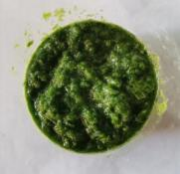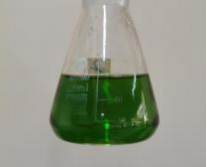May 21, 2025
Tag:
1. Preface
Fenethoxazole is a broad-spectrum and highly effective fungicide, mainly inhibiting the biosynthesis of ergosterol in pathogen cells, thereby breaking through
The structure and function of bad cell membranes. It is mainly used for fruit trees, vegetables, melons and other crops, and has a good protective and therapeutic effect on various fungal diseases of vegetables and fruits. It is one of the safer triazole fungicides. Both foliar treatment and seed treatment can increase crop yield and ensure quality. As healthy intake substances for People's Daily diet, the amount of drug residues in vegetables and fruits is of vital importance. In this study, the JH570 automatic solid-phase extraction instrument was used to test the purification stage of the entire detection process of phenylene ether methyl (?) residue in spinach.
2 Instruments and reagents
2.1 Instruments
JH570 fully automatic solid-phase extraction instrument, gas chromatography-mass spectrometer, tissue homogenizer, centrifuge, rotary evaporator
Instrument, oscillator
2.2 Reagents and Consumables
Ethyl acetate, acetone, n-hexane, anhydrous sodium sulfate, activated carbon solid-phase extraction column (3ml, filler 250mg)
Neutral alumina solid-phase extraction column (3ml, filler 250mg)
N-hexane-acetone (3+2) solution: Take 300 mL of n-hexane, add 200 mL of acetone, shake well and set aside.
3 Experimental Methods
3.1 Experimental Procedures
3.1.1 Sampling
The spinach samples were processed into a paste with a tissue grinder and mixed well for later use.

3.1.2 Extraction
Accurately weigh 10g of uniform sample (accurate to 0.01g) into a 100mL conical flask, add 50mL of ethyl acetate, and then add
15g of anhydrous sodium sulfate was placed on a shaker and shaken for 40 minutes, then filtered. Add 20mL of ethyl acetate to the conical flask again for re-extraction once. Combine the extracts and concentrate under reduced pressure at 40℃ until dry. Dissolve in 3mL of n-hexane and await purification.

(Extract)
3.1.3 Solid-phase extraction column purification
|
Process |
Reagent name |
Dosage |
Speed |
Waiting time |
Air booster |
Nitrogen blowing time |
Frequency |
| Activation sample loading |
Acetone |
5mL |
3mL/min |
0s |
2mL |
0s |
1 |
|
n-hexane |
5mL |
3mL/min |
0s |
2mL |
0s |
1 |
|
|
|
6mL |
2mL/min |
0s |
2mL |
0s |
1 |
|
|
Rinse and sample |
n-hexane |
6mL |
60mL/min |
5s |
5mL |
0s |
1 |
|
The second sample loading |
n-hexane |
12mL |
2mL/min |
0s |
2mL |
0s |
1 |
|
Rinse and sample |
n-hexane |
10mL |
60mL/min |
5s |
5mL |
600s |
1 |
|
Elution |
N-hexane + acetone( 3+2 ) |
5mL |
3mL/min |
5s |
5mL |
0s |
1 |
The collected eluent was blown dry with a nitrogen flow at 40℃. Finally, make up to 1mL with n-hexane and pass it organic at 0.45 μ m
Phase filtration membrane, for gas chromatography-mass spectrometry determination and confirmation.
3.1.4 Gas Chromatography-Mass spectrometry determination conditions
Chromatographic column: Quartz elastic capillary column DB-17ms, 30m*0.25mm (i.d.), film thickness 0.25um, or equivalent; Chromatographic column temperature: Increase from 200℃ to 300℃ at a rate of 10℃/min and maintain for 10 minutes.
Inlet temperature: 300℃
Chromatography-mass spectrometry interface temperature: 280℃
Carrier gas: Helium (purity > 99.999%), 1mL/min; Injection volume: 1 μ l
Injection method: Splitless injection, valve opening after 1.5 minutes; Ionization mode: NCI
Ionization energy: 216.5ev Ion source temperature: 150℃ Quadrupole temperature: 150℃
Reaction gas: Methane, with a purity of no less than 99.99%; Reaction gas flow rate, 2mL/min; Determination method: Select the ion monitoring method;
Selected monitoring ions (m/z) : Quantitative ions 348; Solvent delay for qualitative ions 310,350, and 405:12 minutes.
3.1.5 Chromatographic determination and confirmation
Based on the content of fenethoxazole in the sample solution, a standard working solution with a similar peak area was selected, and the standard working solution and the sample solution were injected in equal volumes. The corresponding values of fenethoxazole in the standard working solution and sample solution should both be within the linear range of the instrument. If in the selected ion chromatograms of the sample solution and the standard working solution, chromatographic peaks appear at the same retention time, and in the sample mass chromatogram after background deduction, all selected ions appear, and the abundance ratio of the selected ions is within the allowable range (the allowable range is shown in the table below) compared to the corresponding ions of the standard solution. Under the determination conditions, the retention time of fenethoxazole was 1.5.74 min, and the abundance ratio of its monitored ions (m/z) was 310:348:350/405 = 45:100:67:13 to confirm it. The external standard method was used to quantify it according to the quantitative ion m/z348.
The maximum allowable error of relative ion abundance when qualitative analysis is conducted using gas chromatography-mass spectrometry
|
Relative abundance (base peak) |
> 50% |
>20%~ 50% |
> 10%~ 20% |
≤10% |
|
Allowable relative deviation |
±20% |
±25% |
±30% |
±50% |
The maximum allowable error of relative ion abundance when qualitative analysis is conducted using gas chromatography-mass spectrometry
4 Results and Discussion
4.1 The experimental process was of the A/B column series type. The sample solution of the A column after solid-phase extraction with activated carbon was directly collected after loading
The liquid is then passed through the neutral alumina solid-phase extraction B-column. The collection tube is rinsed twice with the rinsing solution and passed through the B-column together. Finally, the target substance is eluted from the B-column.
The flow rate of 2mL/min during the sample loading process is clearly stipulated in the national standard.
4.3 Before elution, the small column needs to be drained dry, which can be achieved by setting a nitrogen blowing time of 600 seconds.
4.4 Solid phase extraction method for purifying the residue of diphenyl ether methyl ring ? in spinach purification process is automated to reduce human consumption, the organic solvent used in the experiment is sealed to reduce harm to human body and the instrument can precisely control the flow rate of solvent for activation, loading, elution, etc, to purify the sample more thoroughly.
References
[1]GB 23200.49-2016 National Food Safety Standard - Determination of diphenyl ether methyl ether ? residues in foods - gas chromatography-mass spectrometry
Precautions
The anhydrous sodium sulfate used in the experiment should be calcined at 650℃ for 4 hours and then kept ready for use.
After filtering the sample extract, rinse the filter paper with 10mL of ethyl acetate, and combine the filtrates for later use.
After the sample is dried, dissolve it in a solvent and transfer it to a 10mL sample tube. Then, thoroughly rinse the conical flask with 3mL of the same solvent.
And pour the washing solution together into the sample tube as the loading solution.
4. Both times of sample loading, the sample tubes should be rinsed. A rinsing speed of 60mL/min can achieve spray rinsing, thoroughly washing off the residual sample solution on the tube walls before passing through the column to prevent the residual sample solution from affecting the subsequent test results.
When the activated carbon column is activated, the outflow rate of the activation solution is slow. A 5mL air booster should be set up to ensure that the activation solution fully wets the column before flowing down.
6. When eluting the target substance, appropriately increase the air boost of the instrument to ensure that all the eluent remaining in the column is completely eluted.
7. When toxic and harmful reagents are used in experiments, they should be conducted in a fume hood, and at the same time, the experimenters need to take proper protective measures.


Contact Us
Tel: (+86) 400 610 1188
WhatsApp/Telegram/Wechat: +86 13621645194
+86 15021993094
Follow Us:




 Pharma Sources Insight July 2025
Pharma Sources Insight July 2025


